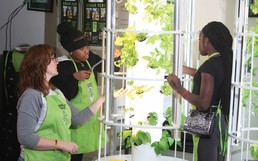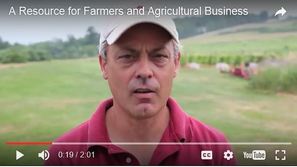|
On
May 8, the Smith-Lever Act of 1914 turned 103 years old. The act established
the nation’s Cooperative Extension System
(CES), a partnership between
the U.S. Department of Agriculture, the land-grant universities, and county
extension offices. Working through land-grant universities and county extension
offices, cooperative extension agents provide research-based, non-formal
education and learning activities to families, farmers, rural, and urban
communities. CES programs include agriculture, family and consumer sciences,
health and nutrition, emergency preparedness, community development, and the
4-H youth development and education program.
Throughout
the month, NIFA will highlight stories on how the CES helps farmers
and ranchers achieve greater success, empowers communities,
educates families, and prepares today’s youth to become tomorrow’s
leaders.
For
more success stories about CES projects across the country, visit the National
Land-Grant Universities impacts database, and a recent report from the National Institute of Food and Agriculture
that examines how federal funding for extension is working to assure that
important research discoveries, innovations, and technologies are brought to
the attention of those needing to implement them.
Success Stories
 Urban oasis in Ohio
Urban GEMS (Gardening Entrepreneurs Motivating Sustainability), uses gardening to engage at-risk youth in Franklin and Mahoning Counties, where communities face high rates of poverty, health issues, unemployment, and food insecurity. The program receives support from NIFA’s Children, Youth and Families at Risk (CYFAR) grant program.
Urban GEMS increases participants’ fresh fruit and vegetable consumption and improves their knowledge of healthy eating, all while learning how to use different systems to grow and harvest crops. Students grow leafy greens on aeroponic towers (growing plants in an air or mist environment without use of soil), learn how to prepare and cook their harvests, teach their peers and families about healthy eating, and donate produce to the homeless. So far, there are tower gardens in nine locations. The research team has plans to create a sustainable business growing food in food deserts with as many as 90 gardens in the next five years. Beyond the gardening benefits, Urban GEMS teaches teamwork, community engagement, and education.
"A lot of students are still wrapping their minds around the fact that Ohio State University and people who have resources are willing to invest in them,” said Dr. Deanna Wilkinson, researcher at Ohio State University. “They are just not used to that. What I want them to know is that they deserve all of the same opportunities as kids who live in communities with more resources.”
Read about Urban GEMS.
|
 South Dakota and livestock
Large-scale livestock producers, known as Concentrated Animal Feeding Operations (CAFOs), create potential water and air quality issues for rural communities in South Dakota. As they develop their operations, CAFOs need to maintain goodwill with neighbors and adhere to environmental laws. Any CAFO that is applying for a general permit must attend a CAFO Environmental Training Program.
South Dakota State University (SDSU) Extension provides training two or three times a year for federal and state water pollution and control programs. The training sessions include topics on livestock production, manure management, and land application practices. In
addition, SDSU Extension specialists discuss how to manage air quality, odor,
and nitrogen and phosphorus content of manure. In 2016, SDSU Extension specialists offered two training sessions. Recent CAFO Environmental Training Programs reached participants from livestock operations that represented approximately 22,500 animals in the beef industry, 4,000 dairy cows, 60,000 pigs, 5 million laying hens, and 3,000 sheep. Survey results showed a 21 to 32 percent increase in the overall understanding of the topics, and more than 63 percent of the participants said they plan to adopt certain practices they learned at the training sessions.
Read the 2016 SDSU Impact Report.
|
News Coverage

Wine, water and California
In San Joaquin Valley, California, researchers are investigating the benefits of using machines to manage growth and production of wine grape vines.
Kaan Kurtural, a University of California Cooperative Extension viticulture specialist, reports mechanized practices account for about 45 percent of the pre-pruning and 17 percent of the precision pruning done in valley vineyards, while 45 percent of the leaf removal work and 7 percent of shoot thinning is done mechanically.
The study identifies ways to reduce costs in wine grape production in a region that sees relatively small profit margins. The research trial, which ran from 2013 through 2015, was conducted in an 80-acre section of a commercial Zinfandel vineyard in Kern County.
Read more about California wine and water.
|
 Capacity funding power
NIFA released a new report that measures the effectiveness of its investments to our nation’s land-grant universities — investments that benefit the American public through agriculture and food research, extension, and education projects. The report reveals that capacity funding offers an essential funding stream that responds to the specific needs of local, regional, and state agricultural producers. The report, “National Evaluation of Capacity Programs,” was prepared by TEConomy Partners.
|
Video
 More to Maine than maple syrup
Maine is 90 percent forested, and the state has more than 8,150 farms, the largest number of any New England state with $3.9 billion in overall economic impact. Maine agriculture is diverse with important sectors that include wild blueberries, potatoes, dairy, livestock, poultry, grains, maple, fruits, vegetables, and a vibrant ornamental horticulture industry. The University of Maine Cooperative Extension plays pivotal roles in supporting a majority of these farms.
Watch Maine Extension in action.
|
Tweet of the Week
#NIFAIMPACTS
|